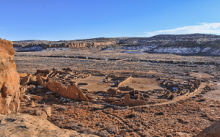Article
In contemporary scholarship, the Anasazi are also referred to as Ancient or Ancestral Pueblo peoples. Neither Navajo nor modern Pueblo society condone the use of the word Anasazi, which is a Navajo word meaning "Ancient Enemy." Ancestral Pueblo culture was concentrated in the Four Corners area of the Southwest, including the present day states of Utah, Colorado, New Mexico, and Arizona, and is known for the range of structures it left behind, especially its cliff dwellings, many of which are found in Many Ruins Canyon (Canyon de Chelly). These ancient Puebloans are also remembered for their extensive use of irrigated agriculture, especially maize (corn), and their intricate pottery designs.
Both prehistoric and modern Puebloans are noted for their masonry structures, known as pueblos. These structures are built in room blocks, generally with a central plaza. These room blocks are stacked upon one another as individual apartments and storage facilities and are accessed from the roof via ladders. In addition to storage and living quarters, within the pueblo complex there are also subterranean ceremonial structures known as kivas.
"Pueblo Bonito at Chaco Culture National Historical Park, a World Heritage Site" by Sam Gao is licensed under CC BY-NC-SA.
Manuscripts
References
Lynch, Patricia Ann
2004 Anasazi. Native American Mythology, Mythology A to Z. New York: Facts On File,
Inc.

